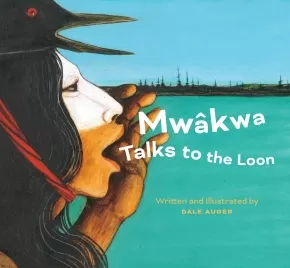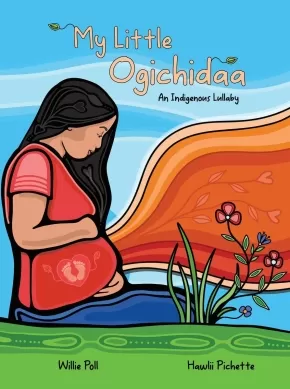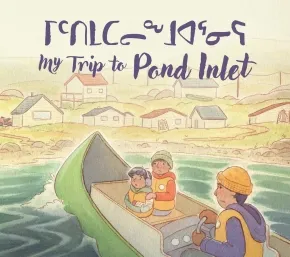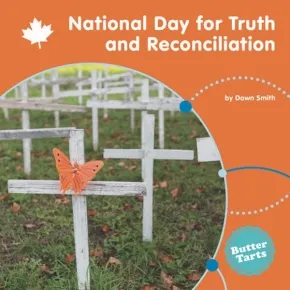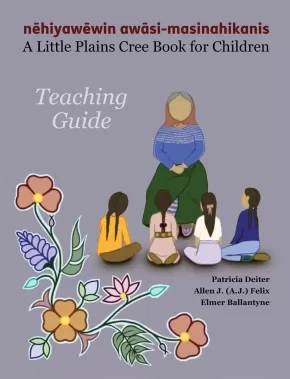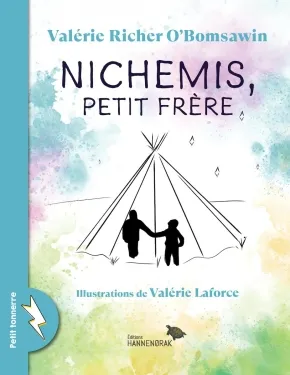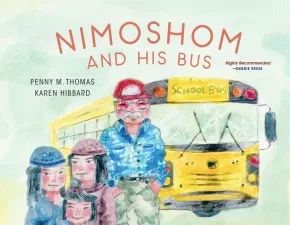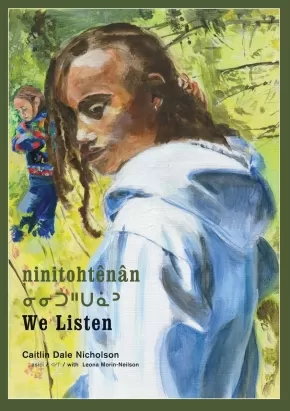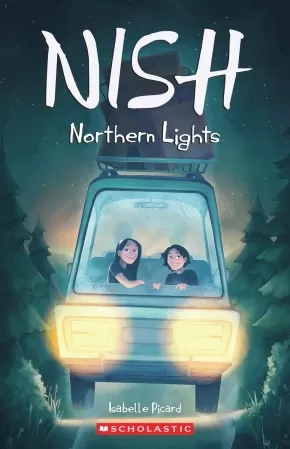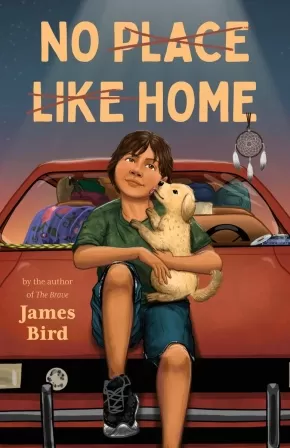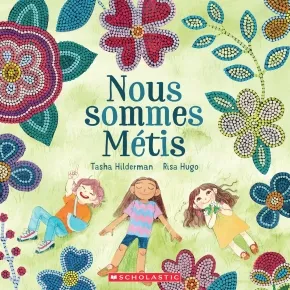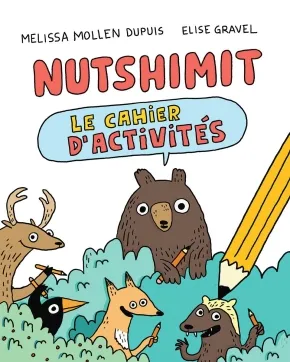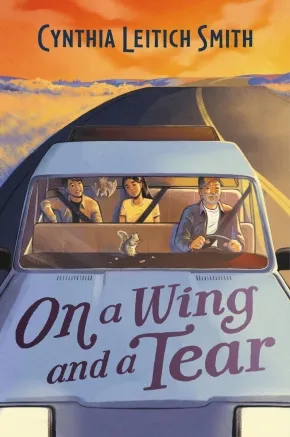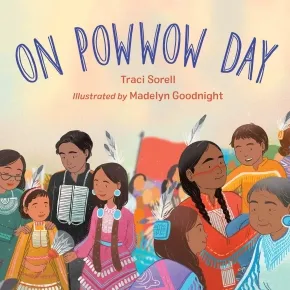
Indigenous Peoples
301
-
315
of
1572 Results;
Sort By
Go To
of 105
Mwâkwa Talks to the Loon: A Cree Story for Children - 2nd Edition
$12.95
Format:
Paperback
Text Content Territories:
Indigenous Canadian; First Nations; Cree (Nehiyawak);
ISBN / Barcode: 9781772034882
Synopsis:
Synopsis:
The award-winning story of a young Cree man blessed with the skills of a great hunter, who learns not to take his talents for granted.
Kayâs is a young Cree man who is blessed with a Gift that makes him a talented hunter. He knows the ways of the Beings he hunts and can even talk with them in their own languages. But when he becomes proud and takes his abilities for granted, he loses his gift, and the People grow hungry.
With the help of the Elders and the Beings that inhabit the water, Kayâs learns that in order to live a life of success, fulfillment and peace, he must cherish and respect the talents and skills he has been given.
Illustrated with Dale Auger's powerful, insightful paintings, Mwâkwa Talks to the Loon introduces readers to the basics of life in a Cree village. A glossary with a pronunciation guide to the many Cree words and phrases used in the story is included.
Awards
- The 1st edition was the winner of the Aboriginal Children's Book of the Year Award, 2006 Anskohk Aboriginal Literature Festival and Book Awards
Educator Information
Recommended Ages: 6-9.
Additional Information
32 pages | 10.00" x 9.25" | Paperback | 2nd Edition
My Little Ogichidaa: An Indigenous Lullaby
$19.99
Artists:
Format:
Hardcover
Text Content Territories:
Indigenous Canadian; First Nations; Anishinaabeg;
ISBN / Barcode: 9781778540301
Synopsis:
Synopsis:
My Little Ogichidaa is inspired by Indigenous motherhood. It invites readers to explore the compelling dreams and hopes of an Indigenous parent for her soon-to-be-born warrior.
The word Ogichidaa itself means warrior in Anishinaabemowin, and this beautifully illustrated book is a tribute to Indigenous families everywhere who are proudly raising their children to carry forward their culture, language, and love with resilience, strength, and kindness. This story is proof that despite colonization, our world is full of Indigenous art, beauty, love, and brilliance. Through the eyes of a mother, readers gain insight into the profound bonds of family and community that are central to Indigenous life. This heartwarming and empowering story is a celebration of Indigenous love and the powerful legacy that it creates.
Educator Information
Recommended for ages 6 to 8.
Find a lesson plan for this book here: My Little Ogichidaa Teacher Lesson Plan
This book is available in French: Ma petite Ogichidaa: une berceuse autochtone
Recommended in the Indigenous Books for Schools catalogue as a valuable resource for English Language Arts and Social Studies, in Grades 2 to 4.
Themes: Ancestors, Decolonization, Resilience, Connectedness to Culture, Family
Additional Information
36 pages | 8.50" x 11.00" | Hardcover
My Trip to Pond Inlet
$16.95
Artists:
Format:
Paperback
Text Content Territories:
Indigenous Canadian; Inuit;
ISBN / Barcode: 9781774507728
Synopsis:
Synopsis:
One rainy day, Solomon is playing inside with his sister. Their mom is cooking polar bear meat in a big pot of water. Suddenly, he trips and burns his arm in the pot of boiling water! The burn is so bad that he must travel to the health centre in the neighbouring community of Pond Inlet. Solomon has to stay in Pond Inlet until his arm heals. Even though Solomon misses his home, he likes playing with the other kids at the health centre and exploring the new and exciting community of Pond Inlet.
Educator & Series Information
Recommended for ages 5 to 7.
In My Trip to Pond Inlet children learn about the responsibility of being safe around hot water and taking care of themselves after an injury.
Dual-Language: English and Inuktitut
This book is part of the Community Connections series.
Additional Information
40 pages | 9.00" x 10.00" | Paperback
National Day for Truth and Reconciliation
$13.95
Format:
Paperback
Text Content Territories:
Indigenous Canadian; First Nations; Nuu-chah-nulth (Nootka);
ISBN / Barcode: 9781774564950
Synopsis:
Synopsis:
Readers are invited to jump into a canoe to learn about residential schools in Canada and the special day for truth and reconciliation. Author Dawn Sii-yaa-ilth-supt Smith is Nuu-chah-nulth and attended Tsartlip Indian Day School in British Columbia. She shares her story and the importance of truth-telling and reconciliation in Canada.
Educator & Series Information
Juvenile Nonfiction
This book is part of the Indigenous Communities in Canada series.
This book is available in French: La Journee nationale de la verite et de la reconciliation
Additional Information
24 Pages
Navajo Code Talkers
$6.99
Format:
Paperback
Text Content Territories:
Indigenous American; Native American; Navajo (Diné);
ISBN / Barcode: 9780744094473
Synopsis:
Synopsis:
Help your child power up their reading skills and learn all about the talented Navajo code talkers during World War II with this fun-filled nonfiction reader–carefully leveled to help children progress.
Navajo Code Talkers introduces kids to the Navajo code talkers sending top-secret messages in code based on their native languages during World War II—and is a motivating introduction to using essential nonfiction reading skills, proving ideal for children ready to enter the riveting world of reading.
Educator Information
This book is a Level 4 DK Super Reader. These books take children on a journey through the wonderful world of nonfiction: traveling back to the time of dinosaurs, learning more about animals, exploring natural wonders and more, all while developing vital nonfiction reading skills and progressing from first words to reading confidently.
The DK Super Readers series can help your child practice reading by:
- Covering engaging, motivating, curriculum-aligned topics.
- Building knowledge while progressing core Grade 4 and 5 reading skills.
- Developing subject vocabulary on topics such as inventions, inventors, and history.
- Boosting understanding and retention through comprehension quizzes.
Each title, which has been leveled using MetaMetrics®: The Lexile Framework for Reading, integrates science, geography, history, and nature topics so there’s something for all children’s interests. The books and online content perfectly supplement core literacy programs and are mapped to the Common Core Standards. Children will love powering up their nonfiction reading skills and becoming reading heroes.
Additional Information
64 pages | 5.94" x 9.00"
nēhiyawēwin awāsi-masinahikanis: A Little Plains Cree Book for Children—Teaching Guide
$74.95
Format:
Coil Bound
Text Content Territories:
Indigenous Canadian; First Nations; Cree (Nehiyawak); Plains Cree;
Reading Level: N/A
ISBN / Barcode: 9781778690273
Synopsis:
Synopsis:
A Little Plains Cree Book for Children—Teaching Guide contains lesson plans, student assignments, and other helpful information for teaching the Plains Cree language—a companion to nēhiyawēwin awāsimasinahikanis: A Little Plains Cree Book for Children: A Reference for Teaching the Plains Cree Language, the content of which focuses on terms familiar to the First Nations Cree people of Saskatchewan and follows curriculum for Kindergarten to Grade 12.
Educator Information
Find the companion resource here: A Little Plains Cree Book for Children: A Reference for Teaching the Plains Cree Language
A colouring book companion is here: A Little Plains Cree Colouring Book: Plains Cree People
Additional Information
128 pages | 8.50" x 11.00" | Spiral Bound
Nichemis, petit frère
$24.95
Artists:
Format:
Hardcover
Text Content Territories:
Indigenous Canadian; First Nations; Abenaki (Wabanaki);
ISBN / Barcode: 9782925118619
Synopsis:
Synopsis:
Nichemis est encore tout petit, mais sa grande sœur se fait un devoir de lui faire découvrir les splendeurs et richesses de leur culture. Au cœur de cette histoire, les liens forts tissés entre la famille et les membres de la communauté s’épanouissent, créant un récit riche en découvertes et en amour fraternel. Nichemis, petit frère est un album tendre qui allie la ferveur de la transmission à la fierté de l’identité abénakise.
Educator Information
Juvenile Fiction
Nimoshom and His Bus (PB)
$14.00
Artists:
Format:
Paperback
Text Content Territories:
Indigenous Canadian; First Nations; Cree (Nehiyawak);
Grade Levels: Preschool; Kindergarten;
ISBN / Barcode: 9781774921166
Synopsis:
Synopsis:
In this warm and joyful picture book highly recommended by Debbie Reese, children learn Cree from Nimoshom, their school bus driver.
Based on the author’s memories of her grandfather, Nimoshom is not your average bus driver. He loves to drive the school bus, tell silly stories, and share his language with the kids who ride his bus.
Nimoshom and His Bus introduces readers to common Cree words and phrases alongside the common childhood experience of riding the school bus. A Cree word list is included in the back of the book.
Reviews
"Through accessible language and engaging visual resources, readers are introduced to basic Cree as Nimoshom responds in this language to the children who ride his bus.... The illustrator’s varying the visuals between full double spreads and single page illustrations keeps the pacing lively. Amidst a rural fall setting, with woodland animals, children, and the school bus, Nimoshom’s humorous nature shines through these gentle illustrations. At the end of this story, you just want to give Nimoshom a great big hug!"— Anita Miettunen, CM: Canadian Review of Materials
"In this bilingual book, readers follow a bus driver picking up kids and dropping them off before and after school. Like the students on the bus, readers quickly learn that the driver's native language is Cree, and he often speaks to them in his native language. Readers learn that "Nimoshom" means "my grandfather" and that "Ekosani" means thank you" as the author (of Cree descent herself) weaves Cree words into the text, and each new spread almost feels like a gentle wave: yes, we're subtly learning new words, but it never feels strenuous or forced, rather it's calm and poetic."— Let's Talk Picture Books
"While Penny M. Thomas' story is not a plot-driven allegory or a message-based lesson, Nimoshom and His Bus is a sweet introduction to some simple Cree words in the context of a common-place activity for many children.... Karen Hibbard who uses watercolours and pastels to create a gentle background for Nimoshom's day on his bus gives the story a grassroots mood, highly appropriate for a routine day of activity and interaction for this bus driver and his charges. It's very relatable."— Helen Kubiw, CanLit for Little Canadians
"If you're a regular reader of AICL, you know that we're always delighted by books by Native writers--especially ones set in the present. Books like Nimoshom and His Bus provide Native children with mirrors that non-Native children find in abundance.... I highly recommend Nimoshom and His Bus! It'd be a simple thing to use other Native words in addition to--or instead of--the Cree words in the book."— Debbie Reese, American Indians in Children's Literature
Educator Information
Recommended for ages 3 to 5.
Additional Information
24 pages | 9.50" x 7.50" | Paperback
ninitohtênân / We Listen
$21.99
Artists:
Format:
Hardcover
Text Content Territories:
Indigenous Canadian; First Nations; Cree (Nehiyawak);
ISBN / Barcode: 9781773068596
Synopsis:
Synopsis:
The third book in the Nôhkom series, in Cree and English, tells a story about gathering leaves for Labrador tea, while listening in different ways.
A child, her family and her friend have arrived at their favorite picnic spot by the lake, but before they eat lunch Nôhkom suggests they pick leaves for Labrador tea. Once among the trees, Nôhkom pauses for a moment to listen, and the others do too. Nôhkom prays, the girls take their turn, then Nôhkom shows them where to find the leaves. Nôhkom and Mom rest after harvesting, but the girls opt for a swim in the lake ... though they're quite happy to warm up afterwards with freshly brewed Labrador tea. And when it's time for the picnic, the girls take another turn at listening.
Beautifully rendered paintings in acrylic on canvas show the family outing. Includes a recipe for Labrador tea as well as a salve made from Labrador Tea leaves.
Educator Information
Recommended Ages: 3 to 7.
Written in short sentences in Cree and English (with Cree text appearing in standard roman orthography and syllabics), the book is a good choice for beginning readers and/or language learners.
This book is the third book in the Nôhkom series.
The story features different forms of listening — in the bush, to teachings from Nôhkom, to the conversation of family and friends (when listening can be especially fun!).
Key Text Features
illustrations
recipe
informational note
Correlates to the Common Core State Standards in English Language Arts:
CCSS.ELA-LITERACY.RL.1.2
Retell stories, including key details, and demonstrate understanding of their central message or lesson.
CCSS.ELA-LITERACY.RL.1.7
Use illustrations and details in a story to describe its characters, setting, or events.
Authenticity Note: Translator Leona Morin-Neilson is the inspiration for the stories and art in the Nôhkom series, which highlights her traditional knowledge of the uses of wild plants. She collaborated with the author to create this work and translated it into Cree.
Because of the collaboration between Leona and the author, and Leona's Cree translation, this book has been labelled as containing Authentic Indigenous Text. It is up to readers to determine if this work is authentic for their purposes.
Additional Information
24 pages | 8.50" x 12.25" | Hardcover
Nish: Northern Lights
$14.99
Format:
Paperback
Text Content Territories:
Indigenous Canadian; First Nations; Innu (Montagnais-Naskapi);
ISBN / Barcode: 9781039704558
Synopsis:
Synopsis:
The second book in Isabelle Picard’s bestselling coming-of-age series about Innu twins, Leon and Eloise.
Leon and Eloise are 13-year-old twins from Matimekush, an Innu community in Northern Quebec.
The entire Mckenzie family has moved to Wendake, near Quebec City. Leaving Matimekush, nature, their friends and their school is quite a challenge for Eloise and Leon. Between the adapting to a different world, their desire to make new friends and the need to keep their bond with the old ones, everything goes too fast.
At school, a student bullies Eloise, and she has to deal with this difficult situation. As for Leon, he starts doubting his hockey skills: Is he really talented or was he the best in Matimekush only because the competition simply wasn’t as strong? In the midst of this storm, Leon and Eloise can always count on each other as well as their family and friends.
The Mystery unfolds on every page as we get to see the twins in a different light. What if, ultimately, life in the South isn’t that different from life in the North?
Educator & Series Information
Recommended for ages 10 to 14.
Translated by Kateri Aubin Dubois, a freelance translator and a prolific beadworker. Her beadwork can be found under her Indigenous name, Nisnipawset. Kateri is from the Wolastoqiyik Wahsipekuk First Nation. She lives with her husband, two children and a fluffy cat in Terrebonne, Quebec.
This is the second book in the Nish series.
Additional Information
296 pages | 5.00" x 7.75" | Paperback
No Place Like Home (PB)
$11.99
Format:
Paperback
Text Content Territories:
Indigenous American; Native American; Anishinaabeg; Ojibwe (Chippewa);
ISBN / Barcode: 9781250877611
Synopsis:
Synopsis:
A middle-grade novel by James Bird about homelessness and hope.
When home is a car, life is unpredictable. School, friends, and three meals a day aren't guaranteed. Not every town has a shelter where a family can sleep for a night or two, and places with parking lots don't welcome overnight stays.
Opin, his brother Emjay, and their mother are trying to get to Los Angeles, where they hope an uncle and a new life are waiting. Emjay has taken to disappearing for days, slowing down the family's progress and adding to their worry.
Then Opin finds a stray dog who needs him as much as he needs her, and his longing for a stable home intensifies, as his brother's reckless ways hit a new high. Opin makes a new friend in the shelter, but shelters don’t allow dogs…
Will anything other than a real home ever be enough?
Reviews
"Author Bird crafts this deeply felt ode to familial love with authoritative prose.... Opin's palpable fears, joys, and unrelenting hope buoy this tale of resilience." -- Publishers Weekly, starred review
"James Bird, who has been homeless and is of Ojibwe descent, writes with rare authority, insight, and compassion that invites deep empathy from readers. He has done a beautiful job of creating an unforgettable family, who, as Inde says, “may be broke, but we’re not broken.” -- Booklist, starred review
"Bird seamlessly weaves in historical events, like the government’s distribution of smallpox-infested blankets to kill Native people, while telling a story of admirable resilience. A thought-provoking story of one boy playing his own game of life. (song list, Ojibwe glossary, author’s note)." - Kirkus Reviews
Educator Information
Recommended for ages 10 to 14.
Subjects / Themes: Poverty, Homelessness, Pets, Pet Adoption, Ojibwe.
Includes some Ojibwe words and a glossary.
Additional Information
320 pages | 5.13" x 7.62" | Paperback
Nous sommes Métis
$14.99
Artists:
Format:
Paperback
Text Content Territories:
Indigenous Canadian | Métis|
ISBN / Barcode: 9781039706019
Synopsis:
Synopsis:
Que vous soyez Métis ou non, il y a tant à découvrir et à apprendre sur cette étonnante culture autochtone. Partez à la découverte de l’artisanat, de la musique et de la cuisine des Métis!
Des enfants d’origine métisse partagent et explorent différentes façons de célébrer leur patrimoine : en goûtant des aliments traditionnels comme la bannique et les baies d’amélanchier, en pratiquant le perlage, en racontant des histoires, en dansant, en jouant de la musique et en chantant. Chaque enfant partage une façon d’honorer ses origines et de tisser des éléments de la riche tapisserie que constitue la culture des Métis. L’un des enfants, cependant, a grandi en étant coupé de son histoire et ne peut pas partager son expérience... Mais il n’est jamais trop tard pour apprendre, célébrer ou faire partie d’une communauté dans laquelle Métis et non-Métis peuvent découvrir la richesse d’une culture souvent négligée.
Ce livre joyeux et rythmé encouragera les jeunes lecteur·rices de toutes origines à célébrer leur propre patrimoine et à en apprendre davantage sur l’histoire des Métis. Il contient également une note de l’autrice, une recette et un glossaire.
Educator Information
Recommended for ages 3 to 7.
This book is available in English: Métis Like Me.
Additional Information
40 Pages | Paperback
Nutshimit: Le cahier d'activités
$18.99
Artists:
Format:
Paperback
Text Content Territories:
Indigenous Canadian; First Nations; Innu (Montagnais-Naskapi); Ekuanitshit; Inuit; Métis;
ISBN / Barcode: 9781039708259
Synopsis:
Synopsis:
Inspiré du livre à succès Nutshimit : Un bain de forêt, écrit par Melissa Mollen Dupuis et illustré par Elise Gravel, ce livre d’activités encourage les enfants à apprendre et à s’amuser avec la nature.
Quelle garniture ajouterais-tu à ton morceau de bannique? Peux-tu dessiner les animaux qui vivent dans la forêt? Les futurs artistes sont invités à explorer des activités qui allient apprentissage et divertissement, comme compléter et colorier des illustrations tirées de Nutshimit.
Les auteurs en herbe pourront aussi exercer leur créativité en écrivant des blagues pour un carcajou grincheux et des lettres à leurs ancêtres.
Les esprits curieux seront encouragés à s’aventurer à l’extérieur et à interagir avec la nature pour réaliser certaines activités en s’inspirant du message de Melissa Mollen Dupuis, pour qui la nature est primordiale.
Le livre contient également des activités classiques telles que les points à relier et les mots cachés.
Grâce aux illustrations de style bande dessinée d’Elise Gravel, les lecteurs découvriront l’importance de la nature et laisseront libre cours à leur créativité, en plus d’apprendre quelques petites choses au passage.
English Description:
Based on the bestselling Nutshimit : Un bain de forêt written by Melissa Mollen Dupuis and illustrated by Elise Gravel, this activity book encourages kids to learn and have fun with nature.
What toppings would you add to your piece of bannock? Can you draw in the animals that live in the woods? Future artists are invited to explore activities that blend learning and fun like completing and colouring in illustrations from Nutshimit.
Budding authors will also get to stretch their creative writing muscles by writing jokes for a cranky wolverine and letters to their ancestors.Curious minds are encouraged to venture outside and interact with nature in order to complete some of the activities, drawing inspiration from Melissa Mollen Dupuis's nature-first messaging. And let’s not forget classic activities like connect-the-dots and word searches.
Thoughtfully brought to life by Elise Gravel’s signature comic-style illustrations, readers will discover the importance of natural world, let their creativity soar, and learn a few things along the way.
Educator Information
For ages 6+.
Find the accompanying book here: Nutshimit: Un bain de forêt
Additional Information
8.00" x 9.97" | Paperback
On a Wing and a Tear
$23.99
Format:
Hardcover
Text Content Territories:
Indigenous American; Native American; Anishinaabeg; Odawa (Ottawa); Cherokee; Muscogee (Creek); Seminole;
ISBN / Barcode: 9780062870001
Synopsis:
Synopsis:
A living legend roosting in the backyard. An unmissable game. A hair-raising mystery. A road trip full of adventure and danger. And all the overlapping circles that connect us throughout Creation.
Melanie “Mel” Roberts and Ray Halfmoon may be from different Indigenous Nations, but the friends have become like siblings since the Robertses moved in with the Halfmoons. And they soon welcome a distinguished guest: Great-grandfather Bat, whose wing is injured, has taken refuge in their old oak tree.
A rematch of the legendary Great Ball Game is coming up, with Bat as the star player. Grampa Charlie Halfmoon offers to drive Bat from Chicago down to the traditional playing field outside Macon, Georgia, and Mel and Ray are determined to help out.
Together, they all set off on a road trip—facing adventure, danger, and a hair-raising mystery—on the way to the historic game.
With loving care and boisterous humor, acclaimed author Cynthia Leitich Smith (Muscogee) tells a modern folklore story about friendship, embracing the unexpected, and all the overlapping circles that connect us throughout Creation.
Reviews
"A unique and noteworthy tale that weaves together past and present with humor through stellar, multilayered writing." — Kirkus Reviews (starred review)
Educator Information
Recommended for ages 8 to 12.
Cynthia Leitich Smith incorporates the traditional Muscogee story of the ball game between the Animals and the Birds, and legendary Great-Grandfather Bat, into her novel about modern-day Indigenous characters. Though it nods to the traditional tale, this is an all-new story set in a world that young readers will recognize.
Some of the characters in this work are introduced in other books by the author. Ray and Grampa Halfmoon were first depicted in Indian Shoes. Mel was introduced in a short story in Ancestor Approved. And, the story of Bat is mentioned in the picture book Jingle Dancer. Though this new story stands alone, readers may recognize the characters they already have relationships with that will make the story feel even richer.
Keywords/Themes/Subjects: Family and Community; Blended Family; Mystery; Animals.
Additional Information
240 pages | 5.50" x 8.25"| Hardcover
On Powwow Day (BB)
$10.99
Artists:
Format:
Board Book
Text Content Territories:
Indigenous American; Native American; Cherokee; Cherokee Nation (Cherokee Nation of Oklahoma);
Grade Levels: Preschool;
ISBN / Barcode: 9781623545765
Synopsis:
Synopsis:
In this board book by best-selling Native author Traci Sorell, discover colors, sounds, and counting from one to ten on powwow day!
This eye-catching, interactive board book is sure to keep toddlers engaged. Count one through ten as you make your way through the day of the powwow, looking for colors, family members, jingle dresses, musical instruments, and tribal citizens in this introduction to a traditional Native event.
An award-winning children's picture book adapted to be ready for little listeners in a warm and vibrant board book edition.
Reviews
"A colorful counting book engages children to identify the different visual elements that occur on powwow day. From the car that vrooms to the shaking shiny jingle cones, the exciting expressions catch more beyond the eye. The rainbow palette is shown off in organic and youthful design work. Every number from one to ten has a corresponding color, attached to a powwow day element. Readers can identify and count these elements, from the gray feathers on regalia to the bright moccasins. VERDICT This delightful picture book allows Indigenous children to connect with and feel pride in the abundance of powwow participation, and gives all readers a great counting book full of cultural imagery."—School Library Journal, starred review
Educator Information
Recommended for ages 3 and under.
Additional Information
20 pages | 5.88" x 5.88" | Board Book
Sort By
Go To
of 105

